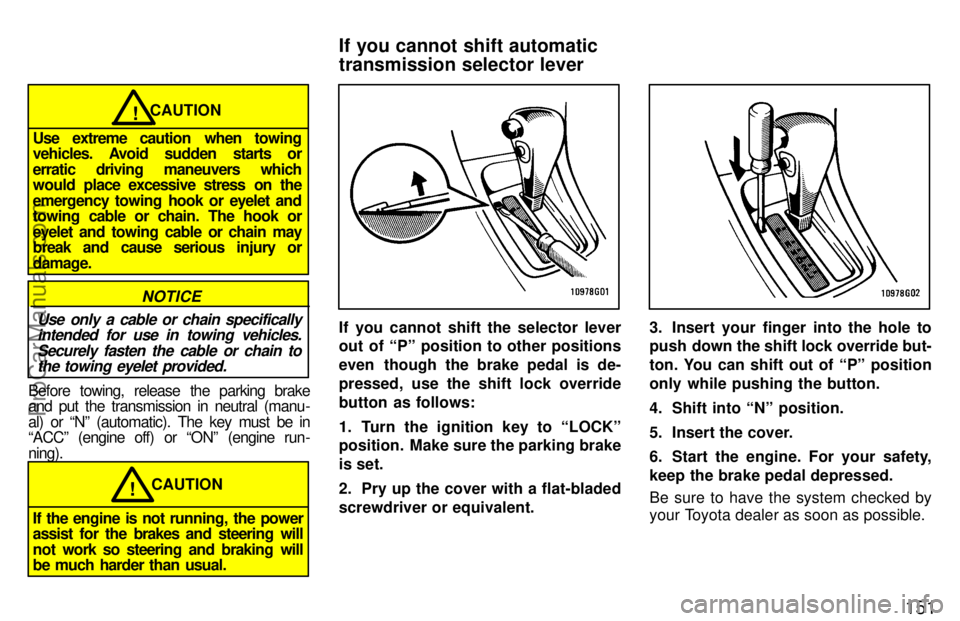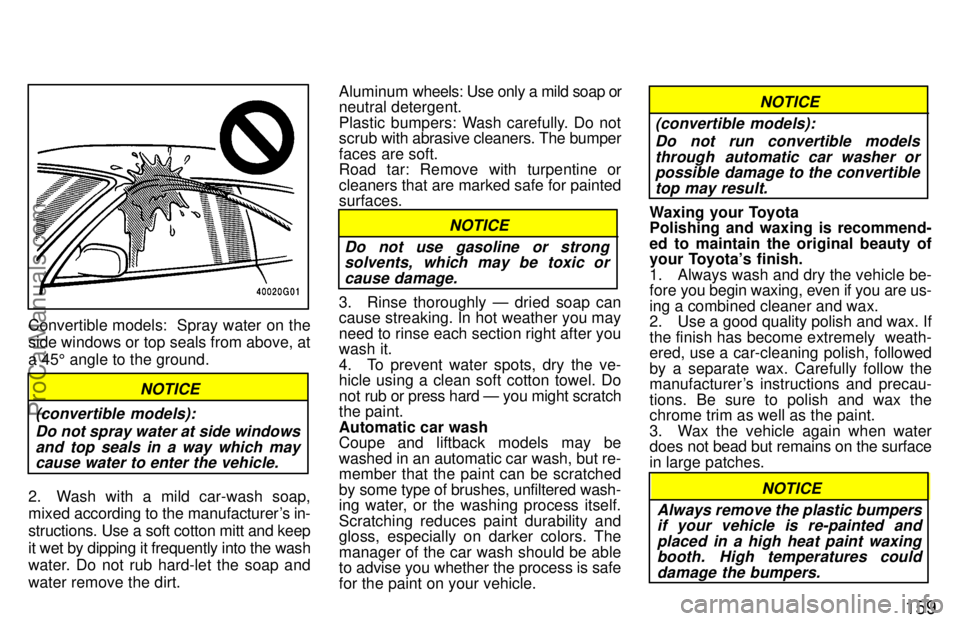Page 157 of 218

151
CAUTION!
Use extreme caution when towing
vehicles. Avoid sudden starts or
erratic driving maneuvers which
would place excessive stress on the
emergency towing hook or eyelet and
towing cable or chain. The hook or
eyelet and towing cable or chain may
break and cause serious injury or
damage.
NOTICE
Use only a cable or chain specifically intended for use in towing vehicles.
Securely fasten the cable or chain tothe towing eyelet provided.
Before towing, release the parking brake
and put the transmission in neutral (manu-
al) or Nº (automatic). The key must be in
ACCº (engine off) or ONº (engine run-
ning).
CAUTION!
If the engine is not running, the power
assist for the brakes and steering will
not work so steering and braking will
be much harder than usual.
If you cannot shift the selector lever
out of Pº position to other positions
even though the brake pedal is de-
pressed, use the shift lock override
button as follows:
1. Turn the ignition key to LOCKº
position. Make sure the parking brake
is set.
2. Pry up the cover with a flat-bladed
screwdriver or equivalent.3. Insert your finger into the hole to
push down the shift lock override but-
ton. You can shift out of Pº position
only while pushing the button.
4. Shift into Nº position.
5. Insert the cover.
6. Start the engine. For your safety,
keep the brake pedal depressed.
Be sure to have the system checked by
your Toyota dealer as soon as possible.
If you cannot shift automatic
transmission selector lever
ProCarManuals.com
Page 165 of 218

159
Convertible models: Spray water on the
side windows or top seals from above, at
a 455 angle to the ground.
NOTICE
(convertible models): Do not spray water at side windowsand top seals in a way which maycause water to enter the vehicle.
2. Wash with a mild car-wash soap,
mixed according to the manufacturer's in-
structions. Use a soft cotton mitt and keep
it wet by dipping it frequently into the wash
water. Do not rub hard-let the soap and
water remove the dirt. Aluminum
wheels: Use only a mild soap or
neutral detergent.
Plastic bumpers: Wash carefully. Do not
scrub w ith abrasive cleaners. The bumper
faces are soft.
Road tar: Remove with turpentine or
cleaners that are marked safe for painted
surfaces.
NOTICE
Do not use gasoline or strong solvents, which may be toxic or
cause damage.
3. Rinse thoroughly Ð dried soap can
cause streaking. In hot weather you may
need to rinse each section right after you
wash it.
4. To prevent water spots, dry the ve-
hicle using a clean soft cotton towel. Do
not rub or press hard Ð you might scratch
the paint.
Automatic car wash
Coupe and liftback models may be
washed in an automatic car wash, but re-
member that the paint can be scratched
by some type of brushes, unfiltered wash-
ing water, or the washing process itself.
Scratching reduces paint durability and
gloss, especially on darker colors. The
manager of the car wash should be able
to advise you whether the process is safe
for the paint on your vehicle.
NOTICE
(convertible models): Do not run convertible modelsthrough automatic car washer orpossible damage to the convertible
top may result.
Waxing your Toyota
Polishing and waxing is recommend-
ed to maintain the original beauty of
your Toyota's finish.
1. Always wash and dry the vehicle be-
fore you begin waxing, even if you are us-
ing a combined cleaner and wax.
2. Use a good quality polish and wax. If
the finish has become extremely weath-
ered, use a car-cleaning polish, followed
by a separate wax. Carefully follow the
manufacturer 's instructions and precau-
tions. Be sure to polish and wax the
chrome trim as well as the paint.
3. Wax the vehicle again when water
does not bead but remains on the surface
in large patches.
NOTICE
Always remove the plastic bumpers if your vehicle is re-painted and
placed in a high heat paint waxingbooth. High temperatures could
damage the bumpers.
ProCarManuals.com
Page 180 of 218

174
NOTICE
�Remember that battery and igni-tion cable carry high currents or
voltages. Be careful of accidental-ly causing a short circuit.
�Add only demineralized or dis-tilled water to fill the radiator. Andif you spill some of the coolant, besure to wash it off with water to
prevent it from damaging theparts or paint.
�Do not allow dirt or anything elseto fall through the spark plugholes.
�Do not pry the outer electrode of aspark plug against the center elec-
trode.
�Use only spark plugs of the speci- fied type. Using other types willcause engine damage, loss of per-
formance or radio noise.
�Do not reuse platinum-tipped
spark plugs by cleaning or regap-ping.
�Do not overfill automatic trans-
mission fluid, or the transmissioncould be damaged.
�Do not drive with the air cleaner fil-ter removed, or excessive engine
wear could result. Also backfiringcould cause a fire in the enginecompartment.
�Be careful not to scratch the glass
surface with the wiper frame.
�When closing the engine hood,check to see that you have not for-gotten any tools, rags, etc.
Here is a list of parts and tools you will
need on performing do-it-yourself main-
tenance. Remember all Toyota parts are
designed in metric sizes, so your tools
must be metric.
Checking the engine oil level
Parts (if level is low):
� Engine oil API SH, Energy-Conserv-
ing IIº multigrade or ILSAC multigrade
having viscosity proper for your cli-
mate
Tools:
� Rag or paper towel
� Funnel (only for adding oil)
Checking the engine coolant level
Parts (if level is low):
� Ethylene-glycol antifreeze
� Demineralized or distilled water
Tools:
� Funnel (only for adding coolant)
Checking brake fluid
Parts (if level is low):
� SAE J1703 or FMVSS No. 116 DOT 3
brake fluid
Tools:
� Rag or paper towel
� Funnel (only for adding fluid)
Parts and tools
ProCarManuals.com
Page 181 of 218

175
Checking power steering fluid
Parts (if level is low):
�Automatic transmission fluid DEX-
RON
[II or III
Tools:
� Rag or paper towel
� Funnel (only for adding fluid)
Checking battery condition
Non-maintenance batteriesÐ
Tools:
� Warm water
� Baking soda
� Grease
� Conventional wrench (for terminal
clamp bolts)
Maintenance type batteriesÐ
Parts (if level is low):
� Distilled water
Tools:
� Warm water
� Baking soda
� Grease
� Conventional wrench (for terminal
clamp bolts)
� Coin (for vent plugs)
� Funnel (only for adding distilled water) Checking and replacing fuses
Parts (if replacement is necessary):
�
Fuse with the same amperage rating
as original
Tools:
� Screwdriver (for passenger's side kick
panel screw)
Adding washer fluid
Parts:
� Water
� Washer fluid containing antifreeze (for
winter use)
Tools:
� Funnel
Replacing light bulbs
Parts:
� Bulb with same number and wattage
rating as original (See charts in Re-
placing light bulbsº in Chapter 7-3.)
Tools:
� Screwdriver
� Conventional wrench
ProCarManuals.com